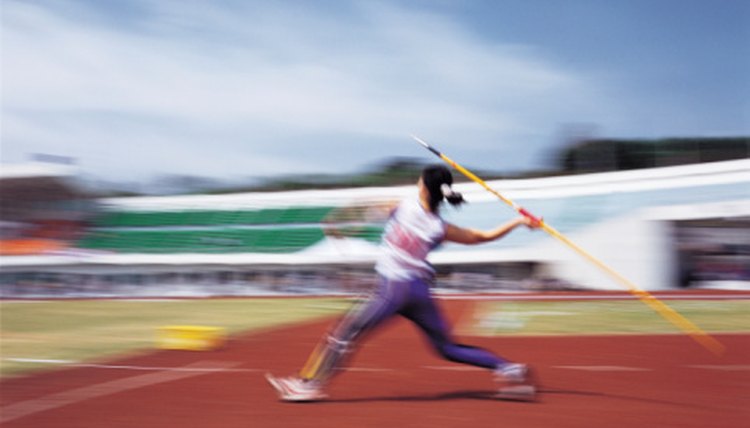Physics of Javelin Throwing

Throwing a javelin involves strength, speed and technique. If a thrower is deficient in one of these aspects, she can still be competitive. However, to be an elite javelin thrower, an athlete must be strong and quick, and have tremendous technique and knowledge on how a javelin flies.
History of Javelin
Javelin throwing has been around since the Ancient Games. It was not until 1780 that it was strictly thrown for distance in the Olympics. In 1986, the javelin that was used in Olympic competition was modified, forcing Olympic throwers to change the angle of their release.
Center of Gravity and Pressure
The two most important factors involving the physics of throwing a javelin are the center of gravity and center of pressure. The center of gravity is near the grip and does not change during throw. "Throwing through the tip," a popular term of how to throw a javelin, means throwing through the grip or center of gravity. The center of pressure is the aerodynamic force of drag and lift on the javelin. The change in 1986 made javelins much easier to throw and much easier to measure because the center of pressure was moved back behind the center of gravity of the javelin.
Attack Angle
Throwing at the optimal attack angle is throwing the javelin at the angle at which the air flows most efficiently around the javelin. To produce maximum distance, the javelin must be thrown at the attack angle to minimize drag and maximize lift and speed. The attack angle for throwing in a head wind is slightly more down causing less lift than when a javelin is thrown into a tail wind.
Throwing Angle

filrom/iStock/Getty Images
No absolute angle will guarantee the farthest distance on each throw. Wind speed and direction change the optimal angle of release significantly. Also, the strength and speed at which the thrower can produce changes the direction at which the javelin should be thrown. Before the 1986 change in javelins, some of the best throwers in the world would throw the javelin with as little as a 30-degree angle but at greater speed because they were able to hold onto the javelin longer, producing more force. Elite throwers now still use this method; however, the most common method is releasing the javelin at about a 40-degree angle, causing more lift and flight to the javelin.
References
Writer Bio
Judson Brooker started writing in 2010. He was a NAIA All-American in indoor track and field while at Cedarville University and a multiple NCCAA All-American in cross country and track and field. Brooker graduated from Cedarville University with a Bachelor of Arts in multi-age physical education.
